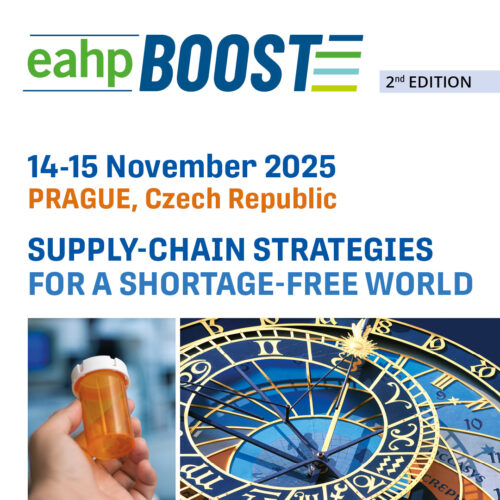COORDINATION OF MEDICATION SHORTAGE MANAGEMENT WITHIN THE PHARMACY SERVICE AND ACROSS HEALTHCARE LEVELS
Pdf

European Statement
Selection, Procurement and Distribution
Author(s)
Palacio-Lacambra, ME
Cabañas-Poy, MJ
Lalueza-Broto, MP
Florensa-Royo, E
Fernández-Polo, Aurora
Marrero-Álvarez, P
Juárez-Giménez, JC
Gabarro-Portella, G
Gorgas-Torner, MQ
Why was it done?
The problems caused by medication shortages are significant, pose a risk to patient care, and require good coordination between different levels of the healthcare system (primary care and hospital pharmacy services (PS)). Drug shortages can adversely affect drug therapy, compromise or delay medical procedures, and result in medication errors.
The objectives of the working group are to define the internal processes of the PS regarding the management of and communication between professionals about medication supply shortages and to coordinate the referral of primary care community patients for dispensing at the hospital.
What was done?
A multidisciplinary working group was established, including representatives from various pharmacy areas (management, outpatient dispensing, drug information center, pediatrics) and representatives from the Primary Care Medication Management Area in our Health Region, where our center serves as the reference hospital.
The “Supplier Shortage Working Instruction” has been updated, and a pathway has been established for referring patients from primary care to the outpatient pharmacies (adult and pediatric) of our hospital.
How was it done?
Internal meetings of the PS were held to update the “Supplier Shortage Working Instruction,” considering the different situations of medications in shortage (exclusive and/or non-substitutable, substitutable, and community pharmacy medications in shortage).
A meeting with Primary Care representatives was conducted to define the pathway for referring community patients with medications in shortage imported from abroad through the Spanish Agency of Medicines and Medical Devices.
What has been achieved?
The internal working instruction has been redefined, and a shared resource for the entire PS has been created to centralize relevant information for the management of medications in shortage, which is kept up-to-date.
A referral pathway has been established for Primary Care patients to the outpatient pharmacies of our hospital. Two pharmacists from the PS coordinate shortage information with Primary Care. Primary Care reports the number of patients with active prescriptions requiring medication, which ensures adequate stock levels and enables patient scheduling to enhance their experience.
What next?
Having an internal pathway has improved the management of medication shortages in the PS, as well as enabled the coordinated referral of community patients.
It is applicable to all PS involved in dispensing foreign medications due to shortages.
Interdisciplinary follow-up of benzodiazepines withdrawal in primary health care
Pdf

European Statement
Clinical Pharmacy Services
Author(s)
Claudia Elias, Alda Morgado, Daniel Amaral , Fátima Cimadeira, Nadine Ribeiro
Why was it done?
Anxiolytics, sedatives and hypnotics consumption in Portugal represents 6,1% of the drug market (1). Their prescription, which should be limited in time, 12 weeks maximum, is often prolonged. As a result, patients experience cognitive deterioration, falling risk increase and tolerance and dependence. As a result, withdrawal phenomena occur, making it difficult to stop BZD. (2) Addressing this problem at the beginning of BZD use is important, avoiding chronic use.
What was done?
An interdisciplinary team was created, involving psychologist, a clinical pharmacist and a general practitioner (GP), of Primary Health Care (PHC) for patients with insomnia or anxiety who accept to participate in the benzodiazepines (BZD) Withdrawal process.
How was it done?
In December 2021, PHC’s GP started eligible patients selection and their referral. The dose reduction schedule is selected by pharmacists and agreed with GP. During the process, psychologists help patients developing skills to overcome psychological barriers; pharmacists monitor the withdrawal process, supporting deprivation management. The interdisciplinary team is in permanent contact, favouring successful withdrawal.
What has been achieved?
Eleven patients were appointed; eight remain in follow-up. Initial prescriptions started for anxiety, insomnia and depression episodes and were continued over time. Intercurrences in personal lives and concomitant therapies changes conditioned delays in withdrawal process. On average, we managed to reduce BZD dose by 25% every 12 weeks, requiring nine pharmacist appointments. Despite difficulties, patients’ motivation and effective BZD reductions and/or ending are the desired health outcomes, suggesting the success of this intervention.
What next?
Currently, we are adjusting the method and the referral process, minimising some of the difficulties faced. We are also presenting the project to new healthcare units, as we intend to guarantee equity in access to the BZD withdrawal programme for all eligible patients.
























